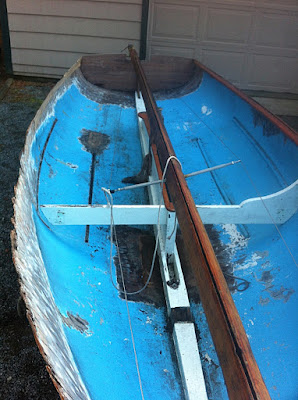U.S. One-Design International 14 - Pre-WW II and immediate Post-WW II
There is considerable confusion when I write about the U.S. One Design International 14 (this being the most common Classic International 14 hull being found for restoration). The International 14 has always been considered a development class. but there was a period before WW II, and the decade after WW II, that major areas of U.S. 14 activity were sailing the 14's as a one-design, with their own rules. (As an aside, U.S. International 14 history is peppered with one-design classes that come directly from the International 14, such as the Jet 14, the Gannet dinghy and, more recently (1990's), another class called the One Design 14, based on the Jay Cross Mk 3 hull, built and marketed by Peter Johnstone.)
The history of the U.S. One-Design International 14 class starts pre WW II, in 1936, right at the beginning, when the founder of the U.S. International 14 class, George Ford, had local boatbuilders producing ribbed copies of the Uffa Fox "R.I.P" design in and around Rochester, New York. George Ford noted the success of American one-design classes of that period (the Snipe, Lightning, Comet, Star) and reasoned it would be better to get this new International 14 class, based on the English rules, off the ground in the U.S. as a one-design hull. George Ford's desire to mass produce a one-design 14 was immediately hamstrung by (in copying from Uffa Fox), the very complicated method of building these "R.I.P" hulls (double planked, about 80+ steamed ribs, thousands of copper rivets). George never quite solved the problem of meeting three criteria at the same time; how to build a "R.I.P." 14 down to weight, strong enough and, given the labor intensive construction, how to build them at a profit. It's hard to determine how many of these R.I.P copies were built (20, maybe 30). In 1938, the Rochester group ran into Sandy Douglass from Ohio at a Put-In-Bay regatta and shortly after that, Sandy Douglass started building ribbed 14's to a more modern and faster hull design than "R.I.P", that of Uffa Fox's later "Alarm" design ('R.I.P" being designed by Uffa in 1931, "Alarm" being designed in 1935). How many ribbed "Alarm's" Sandy Douglass built is unknown. (I've seen the total number of U.S. ribbed 14's built, both "R.I.P" and "Alarm" hulls pegged at 37, but this may be conjecture).
After WWII, around 1945, Sandy Douglass, now in partnership with Ray McLeod Sr, started producing both his famous Thistle sailing dinghy and the "Alarm" design International 14's using the hot molding ply veneer process developed during WW II. (The hull shells were molded by U.S. Molded Shapes in Grand Rapids Michigan - formerly U.S. Plywood - and then trucked back to Vermillion Ohio for completion.) Given the ability to mass produce hot molded ply hulls, the hull of choice for a One-Design International 14 now switched over to the Uffa Fox "Alarm" design. The Rochester fleet, already solidly pro one-design, was now to be joined by another fleet as one-design proponents; the new, upstart International 14 fleet in Southern California. (to be continued.)










































